A Comparison of Person-Centred and Cognitive Behavioural Therapy
VerifiedAdded on 2022/12/26
|7
|1752
|1
Essay
AI Summary
This essay delves into a comparative analysis of the person-centred approach and cognitive behavioural therapy (CBT). It begins by outlining the core tenets of the person-centred approach, emphasizing the inherent capacity for psychological well-being and the importance of empathy, congruence, and unconditional positive regard. The essay then explores CBT, highlighting the role of thought processes in influencing behavior and the use of techniques to identify and replace negative thought patterns. Similarities between the two approaches, such as their focus on the conscious mind, the importance of empathy, and collaborative client involvement, are discussed. The essay also contrasts the two approaches, differentiating between the person-centred approach's emphasis on self-actualization and the CBT's focus on behavior change through cognitive restructuring, as well as exploring differences in intervention strategies and the duration of therapy sessions. The essay draws on several references to support its arguments.
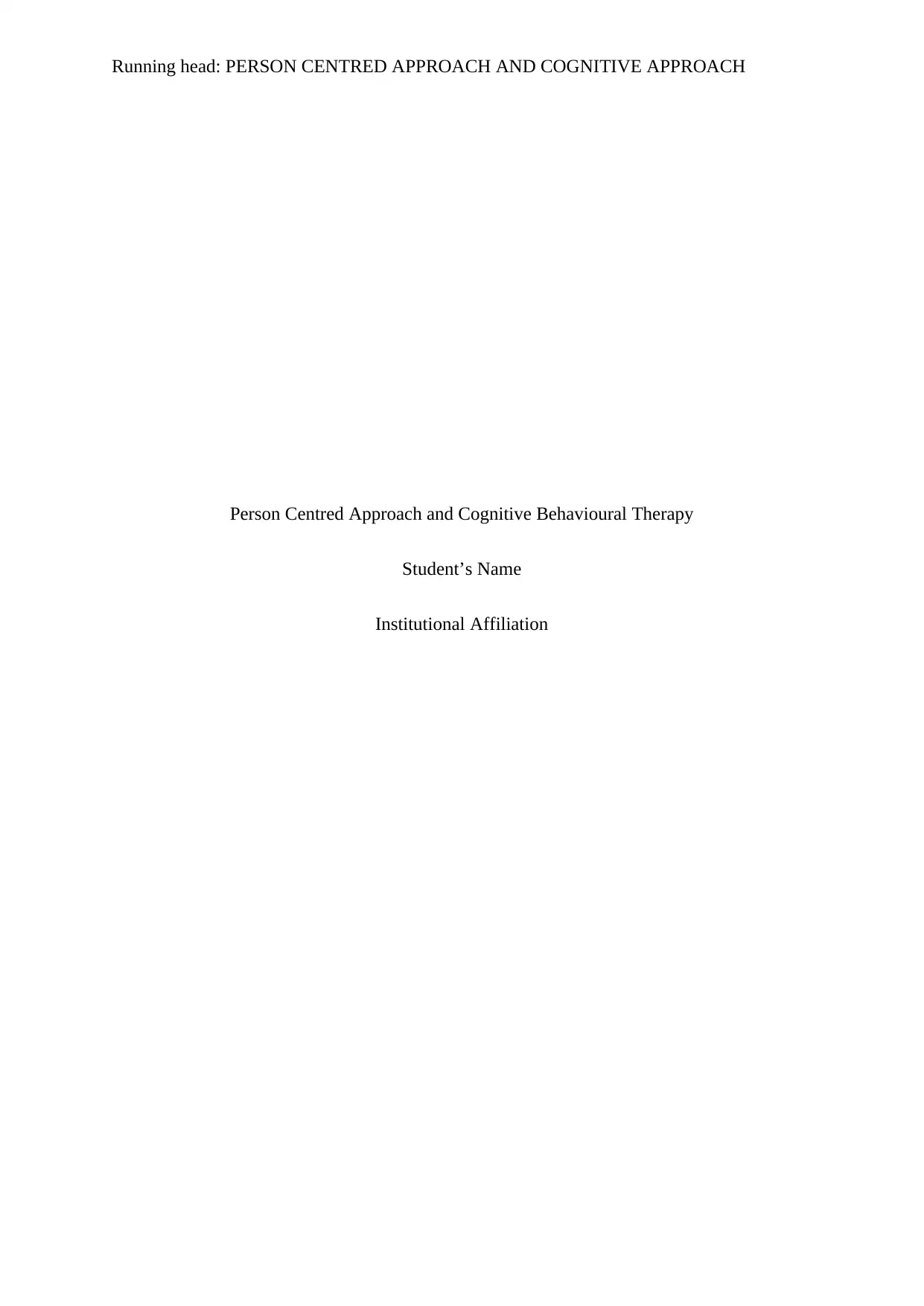
Running head: PERSON CENTRED APPROACH AND COGNITIVE APPROACH
Person Centred Approach and Cognitive Behavioural Therapy
Student’s Name
Institutional Affiliation
Person Centred Approach and Cognitive Behavioural Therapy
Student’s Name
Institutional Affiliation
Paraphrase This Document
Need a fresh take? Get an instant paraphrase of this document with our AI Paraphraser
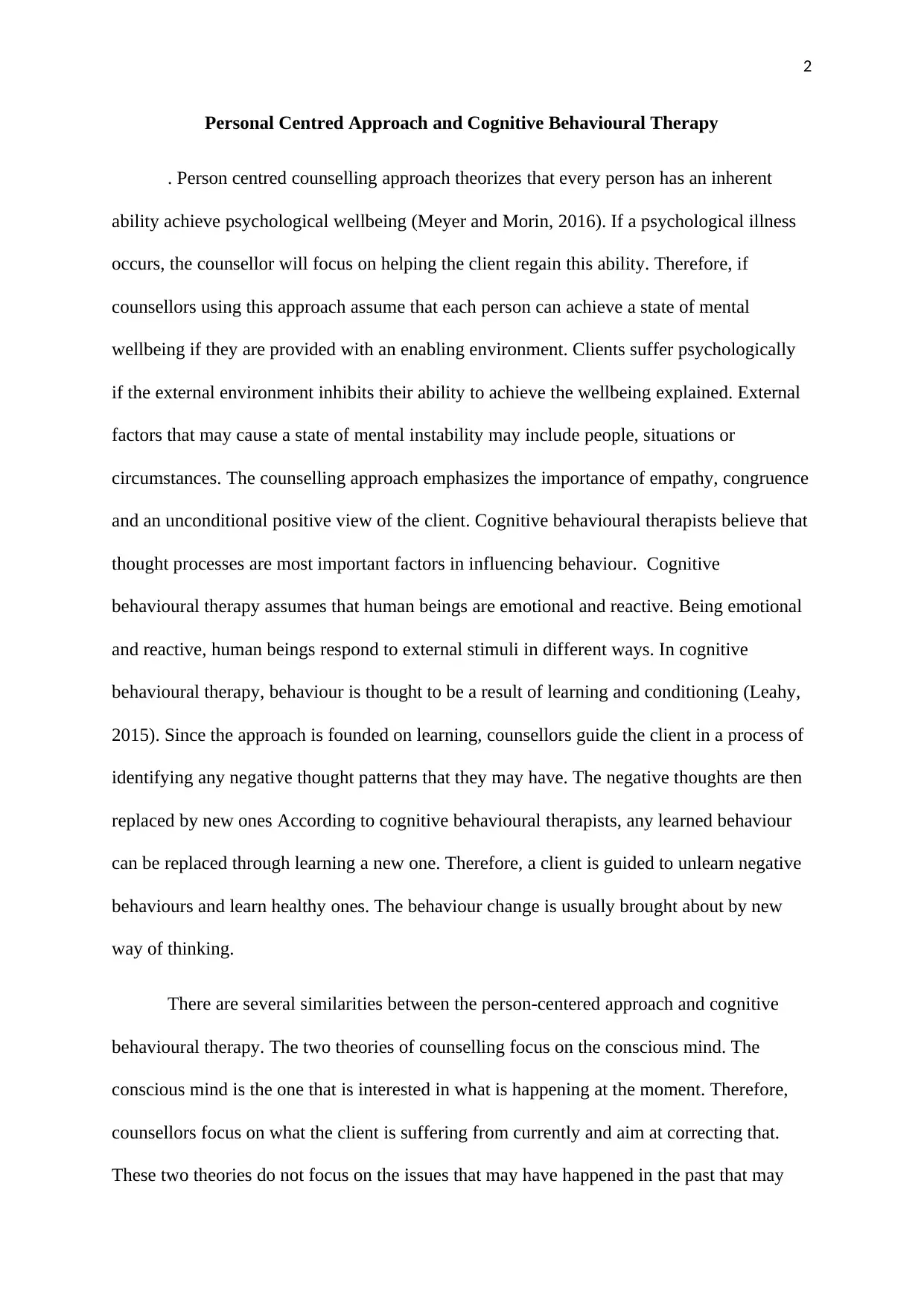
2
Personal Centred Approach and Cognitive Behavioural Therapy
. Person centred counselling approach theorizes that every person has an inherent
ability achieve psychological wellbeing (Meyer and Morin, 2016). If a psychological illness
occurs, the counsellor will focus on helping the client regain this ability. Therefore, if
counsellors using this approach assume that each person can achieve a state of mental
wellbeing if they are provided with an enabling environment. Clients suffer psychologically
if the external environment inhibits their ability to achieve the wellbeing explained. External
factors that may cause a state of mental instability may include people, situations or
circumstances. The counselling approach emphasizes the importance of empathy, congruence
and an unconditional positive view of the client. Cognitive behavioural therapists believe that
thought processes are most important factors in influencing behaviour. Cognitive
behavioural therapy assumes that human beings are emotional and reactive. Being emotional
and reactive, human beings respond to external stimuli in different ways. In cognitive
behavioural therapy, behaviour is thought to be a result of learning and conditioning (Leahy,
2015). Since the approach is founded on learning, counsellors guide the client in a process of
identifying any negative thought patterns that they may have. The negative thoughts are then
replaced by new ones According to cognitive behavioural therapists, any learned behaviour
can be replaced through learning a new one. Therefore, a client is guided to unlearn negative
behaviours and learn healthy ones. The behaviour change is usually brought about by new
way of thinking.
There are several similarities between the person-centered approach and cognitive
behavioural therapy. The two theories of counselling focus on the conscious mind. The
conscious mind is the one that is interested in what is happening at the moment. Therefore,
counsellors focus on what the client is suffering from currently and aim at correcting that.
These two theories do not focus on the issues that may have happened in the past that may
Personal Centred Approach and Cognitive Behavioural Therapy
. Person centred counselling approach theorizes that every person has an inherent
ability achieve psychological wellbeing (Meyer and Morin, 2016). If a psychological illness
occurs, the counsellor will focus on helping the client regain this ability. Therefore, if
counsellors using this approach assume that each person can achieve a state of mental
wellbeing if they are provided with an enabling environment. Clients suffer psychologically
if the external environment inhibits their ability to achieve the wellbeing explained. External
factors that may cause a state of mental instability may include people, situations or
circumstances. The counselling approach emphasizes the importance of empathy, congruence
and an unconditional positive view of the client. Cognitive behavioural therapists believe that
thought processes are most important factors in influencing behaviour. Cognitive
behavioural therapy assumes that human beings are emotional and reactive. Being emotional
and reactive, human beings respond to external stimuli in different ways. In cognitive
behavioural therapy, behaviour is thought to be a result of learning and conditioning (Leahy,
2015). Since the approach is founded on learning, counsellors guide the client in a process of
identifying any negative thought patterns that they may have. The negative thoughts are then
replaced by new ones According to cognitive behavioural therapists, any learned behaviour
can be replaced through learning a new one. Therefore, a client is guided to unlearn negative
behaviours and learn healthy ones. The behaviour change is usually brought about by new
way of thinking.
There are several similarities between the person-centered approach and cognitive
behavioural therapy. The two theories of counselling focus on the conscious mind. The
conscious mind is the one that is interested in what is happening at the moment. Therefore,
counsellors focus on what the client is suffering from currently and aim at correcting that.
These two theories do not focus on the issues that may have happened in the past that may
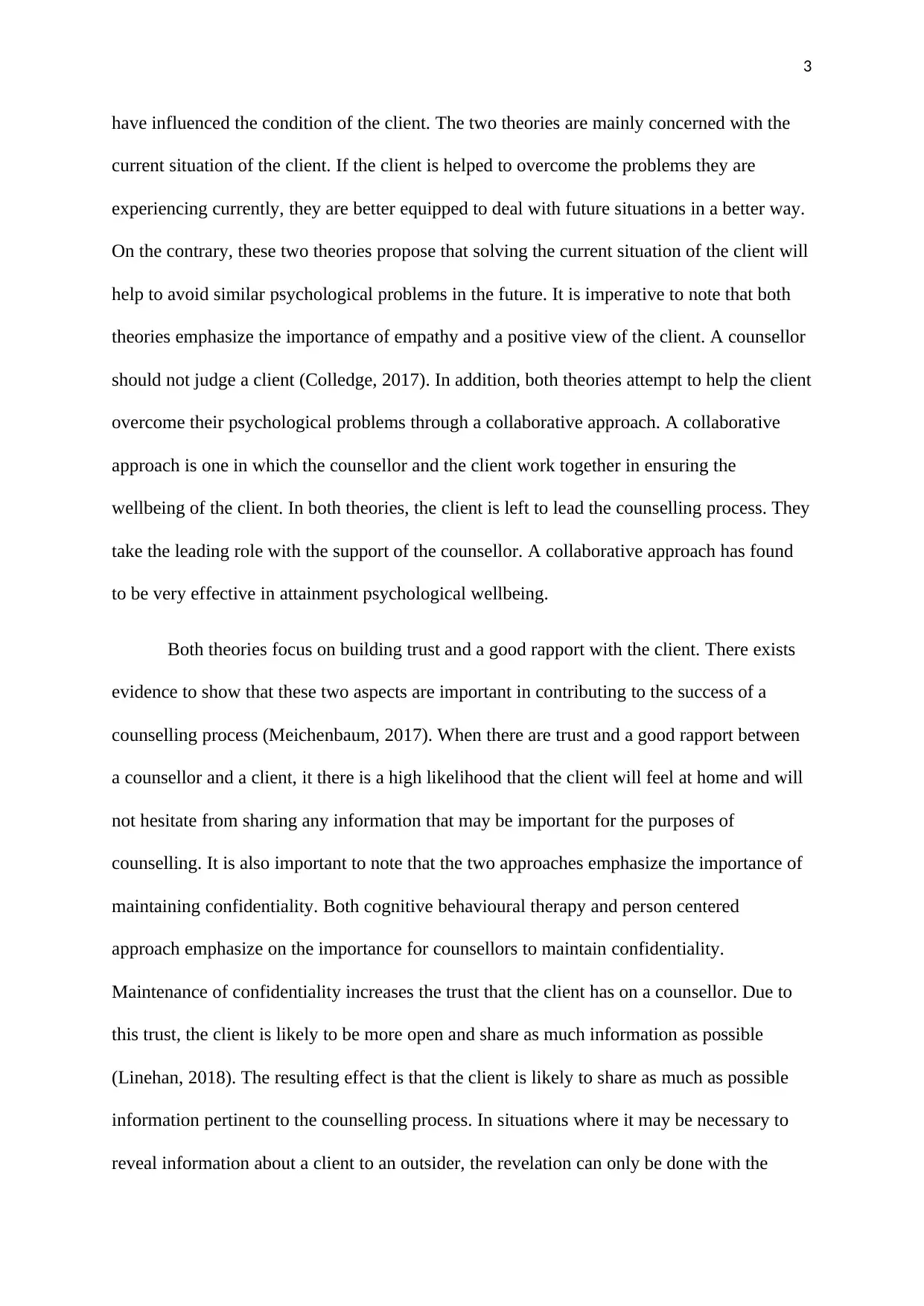
3
have influenced the condition of the client. The two theories are mainly concerned with the
current situation of the client. If the client is helped to overcome the problems they are
experiencing currently, they are better equipped to deal with future situations in a better way.
On the contrary, these two theories propose that solving the current situation of the client will
help to avoid similar psychological problems in the future. It is imperative to note that both
theories emphasize the importance of empathy and a positive view of the client. A counsellor
should not judge a client (Colledge, 2017). In addition, both theories attempt to help the client
overcome their psychological problems through a collaborative approach. A collaborative
approach is one in which the counsellor and the client work together in ensuring the
wellbeing of the client. In both theories, the client is left to lead the counselling process. They
take the leading role with the support of the counsellor. A collaborative approach has found
to be very effective in attainment psychological wellbeing.
Both theories focus on building trust and a good rapport with the client. There exists
evidence to show that these two aspects are important in contributing to the success of a
counselling process (Meichenbaum, 2017). When there are trust and a good rapport between
a counsellor and a client, it there is a high likelihood that the client will feel at home and will
not hesitate from sharing any information that may be important for the purposes of
counselling. It is also important to note that the two approaches emphasize the importance of
maintaining confidentiality. Both cognitive behavioural therapy and person centered
approach emphasize on the importance for counsellors to maintain confidentiality.
Maintenance of confidentiality increases the trust that the client has on a counsellor. Due to
this trust, the client is likely to be more open and share as much information as possible
(Linehan, 2018). The resulting effect is that the client is likely to share as much as possible
information pertinent to the counselling process. In situations where it may be necessary to
reveal information about a client to an outsider, the revelation can only be done with the
have influenced the condition of the client. The two theories are mainly concerned with the
current situation of the client. If the client is helped to overcome the problems they are
experiencing currently, they are better equipped to deal with future situations in a better way.
On the contrary, these two theories propose that solving the current situation of the client will
help to avoid similar psychological problems in the future. It is imperative to note that both
theories emphasize the importance of empathy and a positive view of the client. A counsellor
should not judge a client (Colledge, 2017). In addition, both theories attempt to help the client
overcome their psychological problems through a collaborative approach. A collaborative
approach is one in which the counsellor and the client work together in ensuring the
wellbeing of the client. In both theories, the client is left to lead the counselling process. They
take the leading role with the support of the counsellor. A collaborative approach has found
to be very effective in attainment psychological wellbeing.
Both theories focus on building trust and a good rapport with the client. There exists
evidence to show that these two aspects are important in contributing to the success of a
counselling process (Meichenbaum, 2017). When there are trust and a good rapport between
a counsellor and a client, it there is a high likelihood that the client will feel at home and will
not hesitate from sharing any information that may be important for the purposes of
counselling. It is also important to note that the two approaches emphasize the importance of
maintaining confidentiality. Both cognitive behavioural therapy and person centered
approach emphasize on the importance for counsellors to maintain confidentiality.
Maintenance of confidentiality increases the trust that the client has on a counsellor. Due to
this trust, the client is likely to be more open and share as much information as possible
(Linehan, 2018). The resulting effect is that the client is likely to share as much as possible
information pertinent to the counselling process. In situations where it may be necessary to
reveal information about a client to an outsider, the revelation can only be done with the
⊘ This is a preview!⊘
Do you want full access?
Subscribe today to unlock all pages.

Trusted by 1+ million students worldwide
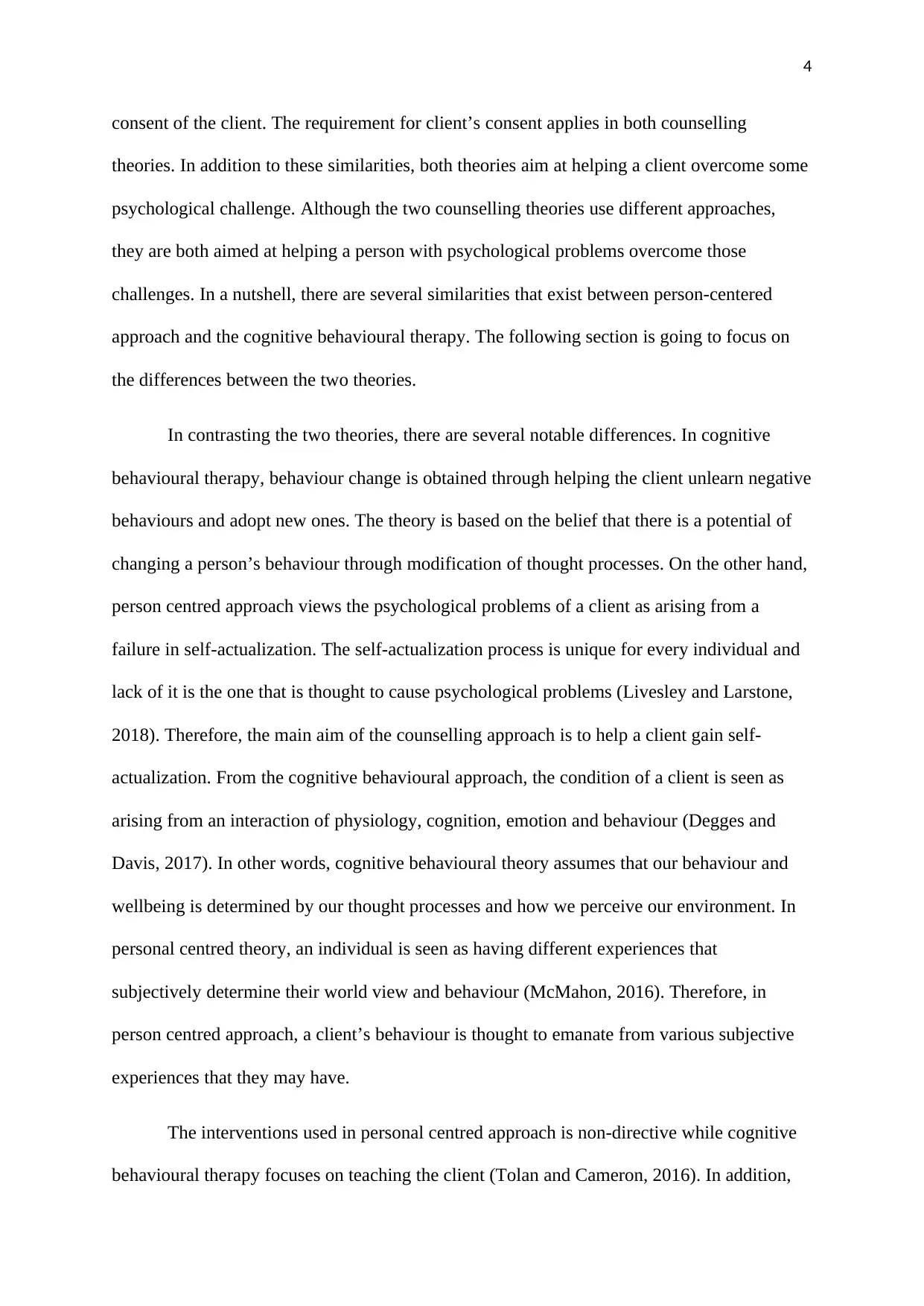
4
consent of the client. The requirement for client’s consent applies in both counselling
theories. In addition to these similarities, both theories aim at helping a client overcome some
psychological challenge. Although the two counselling theories use different approaches,
they are both aimed at helping a person with psychological problems overcome those
challenges. In a nutshell, there are several similarities that exist between person-centered
approach and the cognitive behavioural therapy. The following section is going to focus on
the differences between the two theories.
In contrasting the two theories, there are several notable differences. In cognitive
behavioural therapy, behaviour change is obtained through helping the client unlearn negative
behaviours and adopt new ones. The theory is based on the belief that there is a potential of
changing a person’s behaviour through modification of thought processes. On the other hand,
person centred approach views the psychological problems of a client as arising from a
failure in self-actualization. The self-actualization process is unique for every individual and
lack of it is the one that is thought to cause psychological problems (Livesley and Larstone,
2018). Therefore, the main aim of the counselling approach is to help a client gain self-
actualization. From the cognitive behavioural approach, the condition of a client is seen as
arising from an interaction of physiology, cognition, emotion and behaviour (Degges and
Davis, 2017). In other words, cognitive behavioural theory assumes that our behaviour and
wellbeing is determined by our thought processes and how we perceive our environment. In
personal centred theory, an individual is seen as having different experiences that
subjectively determine their world view and behaviour (McMahon, 2016). Therefore, in
person centred approach, a client’s behaviour is thought to emanate from various subjective
experiences that they may have.
The interventions used in personal centred approach is non-directive while cognitive
behavioural therapy focuses on teaching the client (Tolan and Cameron, 2016). In addition,
consent of the client. The requirement for client’s consent applies in both counselling
theories. In addition to these similarities, both theories aim at helping a client overcome some
psychological challenge. Although the two counselling theories use different approaches,
they are both aimed at helping a person with psychological problems overcome those
challenges. In a nutshell, there are several similarities that exist between person-centered
approach and the cognitive behavioural therapy. The following section is going to focus on
the differences between the two theories.
In contrasting the two theories, there are several notable differences. In cognitive
behavioural therapy, behaviour change is obtained through helping the client unlearn negative
behaviours and adopt new ones. The theory is based on the belief that there is a potential of
changing a person’s behaviour through modification of thought processes. On the other hand,
person centred approach views the psychological problems of a client as arising from a
failure in self-actualization. The self-actualization process is unique for every individual and
lack of it is the one that is thought to cause psychological problems (Livesley and Larstone,
2018). Therefore, the main aim of the counselling approach is to help a client gain self-
actualization. From the cognitive behavioural approach, the condition of a client is seen as
arising from an interaction of physiology, cognition, emotion and behaviour (Degges and
Davis, 2017). In other words, cognitive behavioural theory assumes that our behaviour and
wellbeing is determined by our thought processes and how we perceive our environment. In
personal centred theory, an individual is seen as having different experiences that
subjectively determine their world view and behaviour (McMahon, 2016). Therefore, in
person centred approach, a client’s behaviour is thought to emanate from various subjective
experiences that they may have.
The interventions used in personal centred approach is non-directive while cognitive
behavioural therapy focuses on teaching the client (Tolan and Cameron, 2016). In addition,
Paraphrase This Document
Need a fresh take? Get an instant paraphrase of this document with our AI Paraphraser
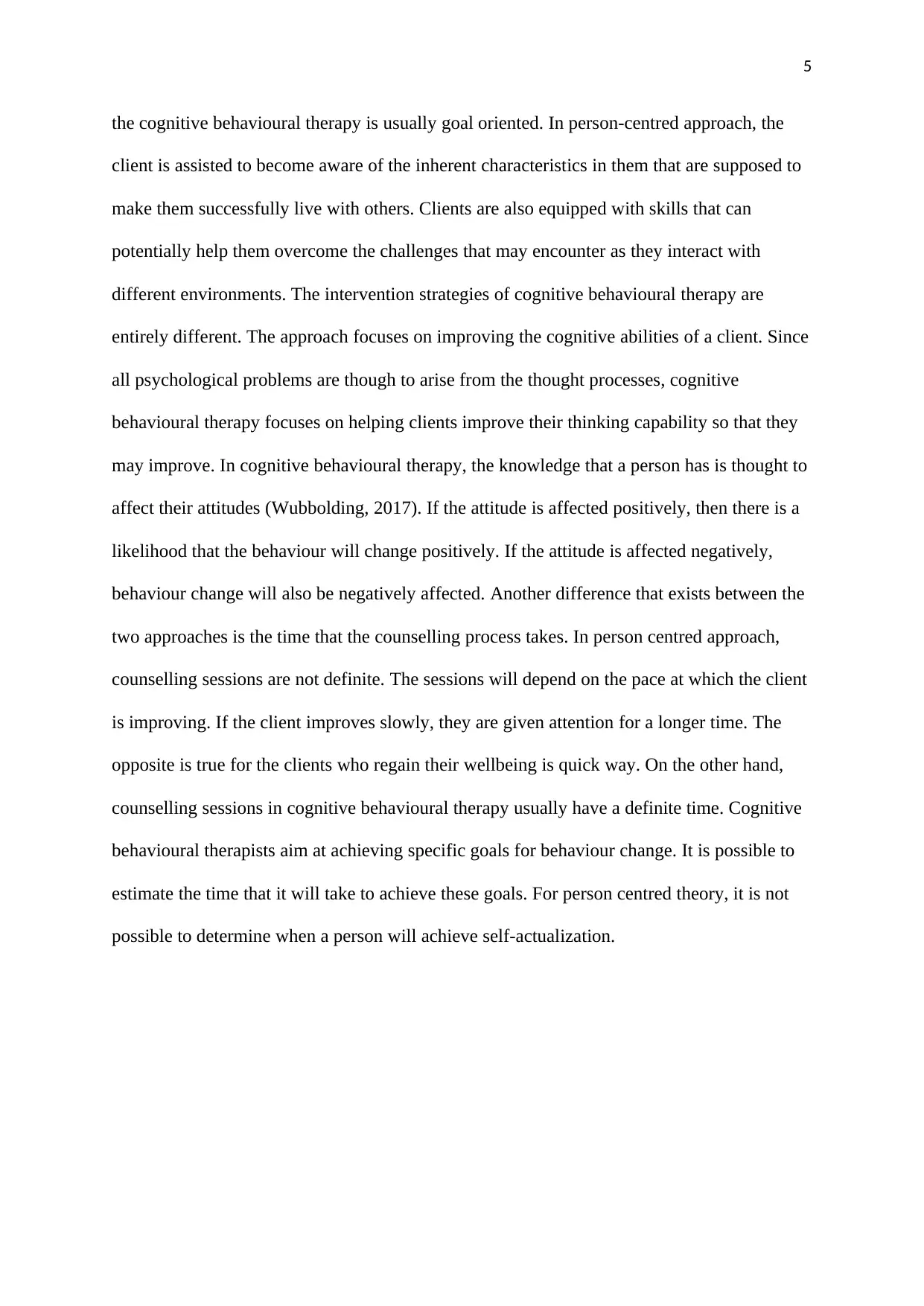
5
the cognitive behavioural therapy is usually goal oriented. In person-centred approach, the
client is assisted to become aware of the inherent characteristics in them that are supposed to
make them successfully live with others. Clients are also equipped with skills that can
potentially help them overcome the challenges that may encounter as they interact with
different environments. The intervention strategies of cognitive behavioural therapy are
entirely different. The approach focuses on improving the cognitive abilities of a client. Since
all psychological problems are though to arise from the thought processes, cognitive
behavioural therapy focuses on helping clients improve their thinking capability so that they
may improve. In cognitive behavioural therapy, the knowledge that a person has is thought to
affect their attitudes (Wubbolding, 2017). If the attitude is affected positively, then there is a
likelihood that the behaviour will change positively. If the attitude is affected negatively,
behaviour change will also be negatively affected. Another difference that exists between the
two approaches is the time that the counselling process takes. In person centred approach,
counselling sessions are not definite. The sessions will depend on the pace at which the client
is improving. If the client improves slowly, they are given attention for a longer time. The
opposite is true for the clients who regain their wellbeing is quick way. On the other hand,
counselling sessions in cognitive behavioural therapy usually have a definite time. Cognitive
behavioural therapists aim at achieving specific goals for behaviour change. It is possible to
estimate the time that it will take to achieve these goals. For person centred theory, it is not
possible to determine when a person will achieve self-actualization.
the cognitive behavioural therapy is usually goal oriented. In person-centred approach, the
client is assisted to become aware of the inherent characteristics in them that are supposed to
make them successfully live with others. Clients are also equipped with skills that can
potentially help them overcome the challenges that may encounter as they interact with
different environments. The intervention strategies of cognitive behavioural therapy are
entirely different. The approach focuses on improving the cognitive abilities of a client. Since
all psychological problems are though to arise from the thought processes, cognitive
behavioural therapy focuses on helping clients improve their thinking capability so that they
may improve. In cognitive behavioural therapy, the knowledge that a person has is thought to
affect their attitudes (Wubbolding, 2017). If the attitude is affected positively, then there is a
likelihood that the behaviour will change positively. If the attitude is affected negatively,
behaviour change will also be negatively affected. Another difference that exists between the
two approaches is the time that the counselling process takes. In person centred approach,
counselling sessions are not definite. The sessions will depend on the pace at which the client
is improving. If the client improves slowly, they are given attention for a longer time. The
opposite is true for the clients who regain their wellbeing is quick way. On the other hand,
counselling sessions in cognitive behavioural therapy usually have a definite time. Cognitive
behavioural therapists aim at achieving specific goals for behaviour change. It is possible to
estimate the time that it will take to achieve these goals. For person centred theory, it is not
possible to determine when a person will achieve self-actualization.
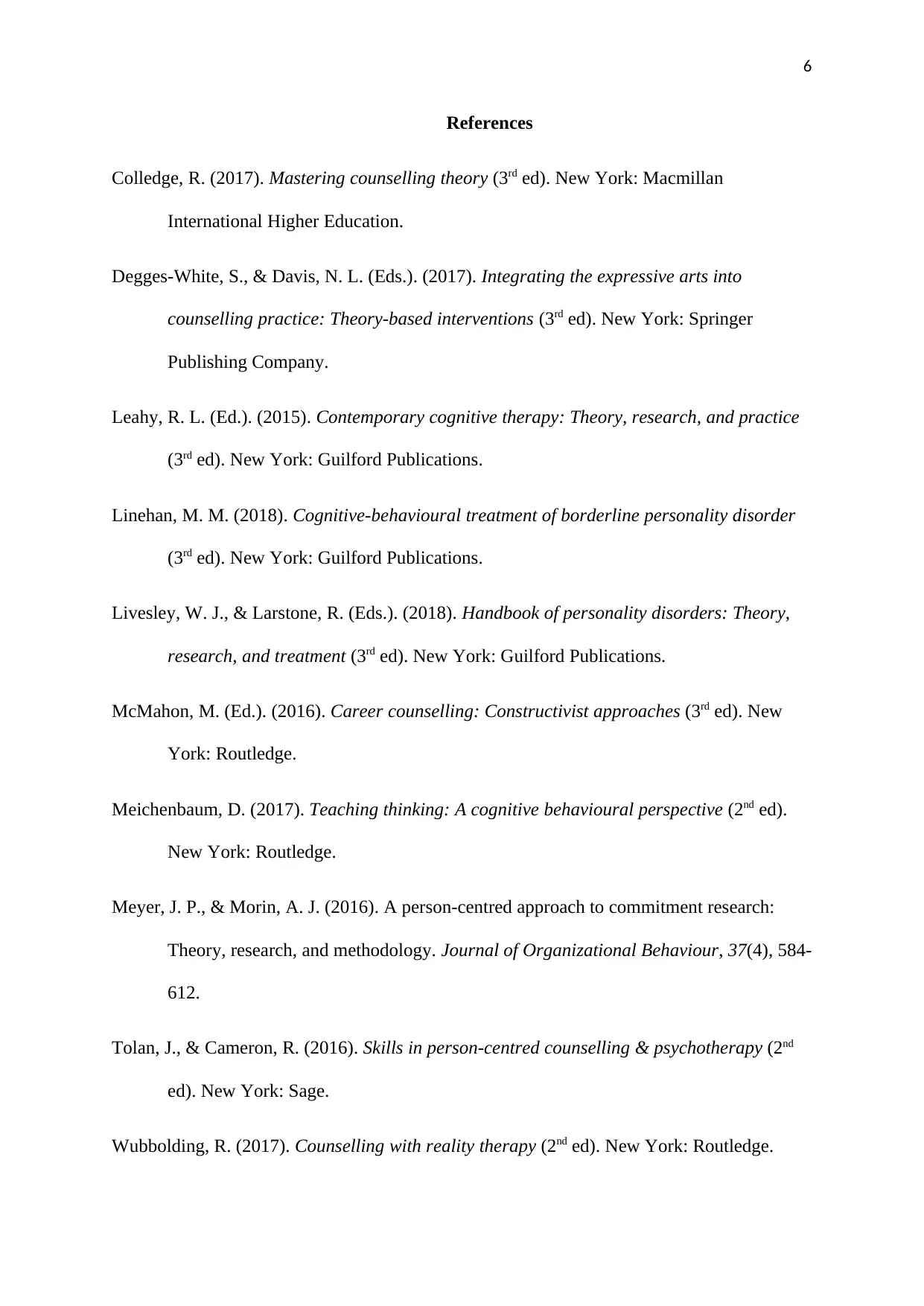
6
References
Colledge, R. (2017). Mastering counselling theory (3rd ed). New York: Macmillan
International Higher Education.
Degges-White, S., & Davis, N. L. (Eds.). (2017). Integrating the expressive arts into
counselling practice: Theory-based interventions (3rd ed). New York: Springer
Publishing Company.
Leahy, R. L. (Ed.). (2015). Contemporary cognitive therapy: Theory, research, and practice
(3rd ed). New York: Guilford Publications.
Linehan, M. M. (2018). Cognitive-behavioural treatment of borderline personality disorder
(3rd ed). New York: Guilford Publications.
Livesley, W. J., & Larstone, R. (Eds.). (2018). Handbook of personality disorders: Theory,
research, and treatment (3rd ed). New York: Guilford Publications.
McMahon, M. (Ed.). (2016). Career counselling: Constructivist approaches (3rd ed). New
York: Routledge.
Meichenbaum, D. (2017). Teaching thinking: A cognitive behavioural perspective (2nd ed).
New York: Routledge.
Meyer, J. P., & Morin, A. J. (2016). A person‐centred approach to commitment research:
Theory, research, and methodology. Journal of Organizational Behaviour, 37(4), 584-
612.
Tolan, J., & Cameron, R. (2016). Skills in person-centred counselling & psychotherapy (2nd
ed). New York: Sage.
Wubbolding, R. (2017). Counselling with reality therapy (2nd ed). New York: Routledge.
References
Colledge, R. (2017). Mastering counselling theory (3rd ed). New York: Macmillan
International Higher Education.
Degges-White, S., & Davis, N. L. (Eds.). (2017). Integrating the expressive arts into
counselling practice: Theory-based interventions (3rd ed). New York: Springer
Publishing Company.
Leahy, R. L. (Ed.). (2015). Contemporary cognitive therapy: Theory, research, and practice
(3rd ed). New York: Guilford Publications.
Linehan, M. M. (2018). Cognitive-behavioural treatment of borderline personality disorder
(3rd ed). New York: Guilford Publications.
Livesley, W. J., & Larstone, R. (Eds.). (2018). Handbook of personality disorders: Theory,
research, and treatment (3rd ed). New York: Guilford Publications.
McMahon, M. (Ed.). (2016). Career counselling: Constructivist approaches (3rd ed). New
York: Routledge.
Meichenbaum, D. (2017). Teaching thinking: A cognitive behavioural perspective (2nd ed).
New York: Routledge.
Meyer, J. P., & Morin, A. J. (2016). A person‐centred approach to commitment research:
Theory, research, and methodology. Journal of Organizational Behaviour, 37(4), 584-
612.
Tolan, J., & Cameron, R. (2016). Skills in person-centred counselling & psychotherapy (2nd
ed). New York: Sage.
Wubbolding, R. (2017). Counselling with reality therapy (2nd ed). New York: Routledge.
⊘ This is a preview!⊘
Do you want full access?
Subscribe today to unlock all pages.

Trusted by 1+ million students worldwide

7
1 out of 7
Related Documents
Your All-in-One AI-Powered Toolkit for Academic Success.
+13062052269
info@desklib.com
Available 24*7 on WhatsApp / Email
![[object Object]](/_next/static/media/star-bottom.7253800d.svg)
Unlock your academic potential
Copyright © 2020–2025 A2Z Services. All Rights Reserved. Developed and managed by ZUCOL.





